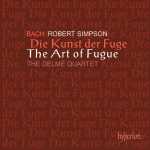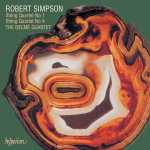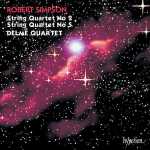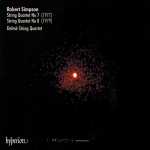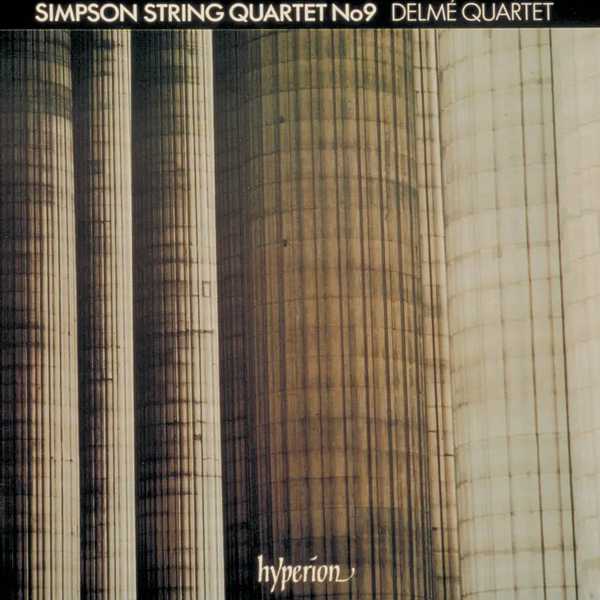
Composer: Robert Simpson
Performer: Delmé Quartet
Format: FLAC (image+cue)
Label: Hyperion
Catalogue: CDA66127
Release: 1989
Size: 296 MB
Recovery: +3%
Scan: yes
String Quartet No. 9
01. No 01. Thema. Tempo di minuetto
02. No 02. Variation 1. L’istesso tempo
03. No 03. Variation 2. Meno mosso, poco espressivo
04. No 04. Variation 3. Poco più mosso
05. No 05. Variation 4. Poco più mosso
06. No 06. Variation 5. Molto allegro
07. No 07. Variation 6. L’istesso tempo
08. No 08. Variation 7. [no tempo marking]
09. No 09. Variation 8. Allegro molto
10. No 10. Variation 9. L’istesso tempo
11. No 11. Variation 10. L’istesso tempo
12. No 12. Variation 11. [no tempo marking]
13. No 13. Variation 12. [no tempo marking]
14. No 14. Variation 13. [no tempo marking]
15. No 15. Variation 14. L’istesso tempo
16. No 16. Variation 15. Lento
17. No 17. Variation 16. L’istesso tempo
18. No 18. Variation 17. Presto
19. No 19. Variation 18. [no tempo marking]
20. No 20. Variation 19. [no tempo marking]
21. No 21. Variation 20. Feroce
22. No 22. Variation 21. Adagio
23. No 23. Variation 22. Allegro
24. No 24. Variation 23. Poco meno mosso
25. No 25. Variation 24. Meno
26. No 26. Variation 25. Allegro molto vivace
27. No 27. Variation 26. Allegretto
28. No 28. Variation 27. L’istesso tempo
29. No 29. Variation 28. Prestissimo
30. No 30. Variation 29. Vivace
31. No 31. Variation 30. Largo
32. No 32. Variation 31. L’istesso tempo
33. No 33. Variation 32. Adagissimo
34. No 34. Finale. Fuga
The Delmé Quartet’s twentieth anniversary in 1982 coincided with the 250th anniversary of the birth of Haydn, and to mark this dual occasion the Quartet asked five British composers to write works for them. Among these was Robert Simpson (b1921); he chose to mark both occasions by dedicating his Ninth String Quartet ‘In affection and admiration’ to the players, and by making the work a very large set of variations on a Haydn theme. Its first performance was given in the Wigmore Hall in London on 6 October, 1982.
This work is a remarkable tour de force. Simpson’s admiration for the players led him to write a quartet lasting some 57 minutes, its performance requiring not only immense technical virtuosity but also great stamina and interpretative power. Moreover, he has explored thoroughly every facet of Haydn’s theme in a way which for fertile imagination, invention, and contrapuntal skill challenges comparison with the variations J S Bach wrote for Goldberg to play to the insomniac Count Kayserling.
But these are not the only reasons why ‘tour de force’ is an apt description. The theme (the Minuet from Haydn’s Symphony No 47 in G, also used in the Piano Sonata in A, Hoboken 26, Landon 21) is a palindrome — that is, the second half is the first played backwards. Never a shirker, Simpson made each of his variations also a palindrome. By his comment ‘It’s not that difficult: all you’ve got to do is write out the first half, then copy it out backwards!’ he made light of his own ability and the struggles of composition. (Anyone taking such a remark at face value might try the experiment of turning Haydn’s fine ‘Emperor’s Hymn’ into something resembling an inferior Victorian hymn tune merely by playing it backwards.) Palindromes are found regularly enough in atonal music, but tonal ones present special problems. Simpson had written variations on this same Haydn palindrome before, for the piano in 1948, and the first three in this much more exploratory quartet work are taken from the early piano set, making a kind of bridge between two different worlds. Palindromes have also been used by this composer in his Quartet No 1 and Symphony No 2, so the Ninth Quartet only searches more deeply a phenomenon that has always fascinated him.
The various kinds of variation to be found in this quartet are not all of the classical kind, which tends to concentrate exclusively on more or less direct melodic, rhythmic, and harmonic parallels. Some of Simpson’s amount to deliberate distortions. XXIII and XXIV are musical Siamese twins, overlapping each other and sharing internal organs, at the same time being completely canonic. (Here one might say that whereas Haydn held a mirror vertically at the end of the first half of his Minuet, Simpson places an additional mirror horizontally through the music, producing a weird re-assortment of the parts in XXIV.) Another canonic pair is formed by XXVI (viola solo) and XXVII (duet between second violin and high cello), lyrical variations on the theme starting in the middle instead of the beginning, but still going round in a palindromic circle. The work as a whole aims at being a compendium of both ‘normal’ and unusual variational techniques as seen by this composer — but it also embraces a very wide range of human expression.
Simpson has been consistently interested in the on-going energy of sonata or symphonic music. Palindromic variations or fugue might seem to deny such an involvement. He can, however, still create this sense of movement on a large scale by yoking variations together and by means of an overall tonal scheme. The theme is in G, and the first fourteen variations are in that key. Variations XV – XIX descend in tonality by tones — F, E flat, D flat, B, A, and this brings back G for Nos. XX – XXII. From XXIII onwards the pitch rises by tones from the semitone above G — A flat, B flat, C, D, E, F sharp. G is retained with Variation XXIX. By this means all twelve tonalities are traversed.
Variations XVII – XXV (the first three of these buzzing like insects) might be said to form a scherzo group, with the mysterious XXI (which distributes segments of the theme strangely among the instruments) acting perhaps like a slow trio interrupting the sequence of fast movements. Variations XXX – XXXII make a great slow movement, moving towards an effect not unlike tha t of Beethoven’s ‘Heilige Dankgesang’ in the A minor Quartet, Op 132. The last note of the final Variation becomes the beginning of the Fugue.
The Fugue makes an enormous finale, rising quietly and harmoniously out of Variation XXXII. Slowly the tension is raised until the strenuous energy we associate with the Grosse Fuge is attained. As the Fugue progresses, its subject develops into ever newer forms; the final versions are quite unlike the opening statement, yet the listener — by following the gradual evolution — can easily hear the connections. It will help to focus on the first shape in Haydn’s tune (G, F sharp, D) and its inversion; these are ubiquitous.
Simpson’s opening subject uses the rising version, but the second voice inverts it, so substituting a straightforward major key for a modal colour and thereby enlarging the harmonic perspectives of the music. Towards the end of the Fugue the two types of harmonic colour are presented simultaneously as mirror images, yet neither triumphs over the other since the images hold each other in balance. The music is eventually called home by the first violin’s insistence on the open G string — acting like the vortex of a whirlpool, irresistibly drawing all the other instruments from the musical maelstrom into itself.
Such is the richness of the invention in this Quartet that it would be impossible to do it justice in words; each listener will constantly find new delights, and new illuminations of Haydn’s exquisite Minuet. Simpson’s imagination has produced a work which is by turns evocatively lyrical, explosively powerful, serenely meditative, and blazingly energetic; a work which offers us stillness of mind and body as well as the teeming activity of the world.
